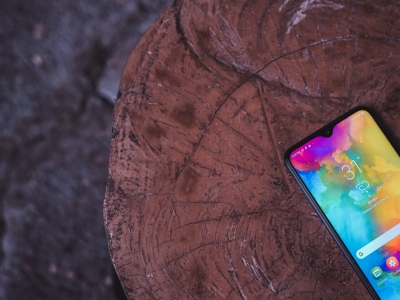
Thanks to a number of new technological advances, those virtual touch-screen keyboards feel much closer to the standard electromechanical models. We can now get enhancements like surfaces and tactile feedback that look much closer like physical keyboards. Will those electromechanical keyboards eventually fade away and be replaced entirely by virtual keyboards?
On many handheld devices, virtual on-screen keyboards have slowly replaced physical keyboards, except on a few smartphones models like BlackBerry. On the computer front, manufacturers have introduced two displays; the top screen is for the main display, while the bottom screen can be used additional display or virtual keyboard. Of course, this configuration is still far from being mainstream; but it may indicate that keyboards’ days are already numbered. However, some people may argue that physical keyboards are still irreplaceable for tasks that involve intensive content creation.
Another place where virtual keyboards seem to dominate is on tablet segments. As applications for tablet become more demanding, surely more advanced and comfortable keyboards are needed. For example, tablet users still feel that virtual keyboards are inadequate for intensive typing, as the result many of them buy an optional external keyboard. It seems that today’s virtual keyboard is not good enough for current requirements.
Future touch-screen keyboard may include touch-based feedback or haptics, for better user experience. Users can get tactile feedback, in form of, intensity, direction and frequency, to provide ‘key click’ sensations. When integrated with proper audio-visual inputs, those vibrations may fool our brains into thinking that we have just pressed a “real” key. Many companies are focusing their researches on haptics to replicate the sensations of using a real keyboard. If virtual keyboards can offer those sensations accurately, it could be another nail on the physical keyboard’s coffin.
Immersion Corp., said that their mechanical actuators can offer haptic feedback on virtual keyboard to replicate keyboard clicks and key travel. Even so, basic tactile feedback may not be enough to replicate physical keyboards. If you have used physical keyboards for many years, haptics can’t completely duplicate the experiences. For example, when using a physical keyboard, you often realign your fingers to sense the edges of each key; it helps you to type quickly without looking at the keyboard.
Feeling the key edges on a smooth virtual keyboard is well nigh impossible. It is difficult to have a surface feel. Pacinian Corp. tries to provide a solution by giving different sensation on each key. Unfortunately, this solution is currently rather limited. You can only get one sensation at a time. For example, hitting two keys at once won’t give you two simultaneous sensations. Pacinian is working to improve its technology. The technology is further complicated by the fact that, capacitive touchscreen works by detecting fingers’ conductivity, a touch is immediately registered and you won’t have the opportunity to orient your fingers.
It means an on-screen virtual keyboard can only better simulate physical keyboards, when it combines force-sensing technology and tactile feedback. However, for high-performance typists, who regularly roll along at hundreds of words each minute, even an improved virtual screen may ruin their productivity.
Another exotic solution is being studied, Immersion is working on “deformable surfaces”, where certain areas on the virtual keyboard can rise up, to give users real physical sensation on a touch-screen keyboard. Pacinian is pursuing on the use of different material, electro active polymers. Many deformable surface materials are still in research labs, while major manufacturers, such as Nokia, Apple and Microsoft have a few patents on this technology. Even if the technology does work, there are still reliability and robustness issues that are need to be solved, especially when we consider variable factors like humidity and temperatures.
Although, virtual keyboard is currently inadequate for many serious typists, it will eventually get better. Some experts even believe that, virtual keyboard will be good enough for intensive data entry, although it may still take years away. Some manufacturers have introduced all-in-one PCs and laptops that use touch-screen keyboards, and they may enter the market in one or two years, but it may take five years or more for them to be used in high volume.
Unfortunately, HP isn’t seriously considering about the use of haptics in its upcoming Touchsmart PCs that will use capacitive- touch-screen keyboards. TouchSmart is definitely an early generation of a new computing style. Observers say that its keyboard is still awkward to use and some believe that these computers won’t have a good recognition among real office workers. So, certain people may buy them simply for fashion and decorative purposes, instead of for functional purposes.
Even a strategy analyst on Synaptics Inc, a touch-screen manufacturer, still can’t see whether physical keyboards will be simulated entirely by its virtual cousins anytime soon, due to hard-to-duplicate electromechanical aspects. He argued that virtual keyboards shouldn’t try to act like physical keyboards; instead touch-screen keyboard manufacturers should concentrate on improving their advantages. For example, the Swype technology, like in Galaxy Tab and Galaxy S, allows quick typing simply by dragging finger across the letter. Some users even claim that once people get used to this technology, they won’t use physical keyboards again. Other benefits of virtual keyboards are the possibility of using word prediction and real-time error correction. However, there is a limit on the number of gestures that can be used. It is unrealistic to expect common users to learn more than 20 gestures, for example. Like voice input, we can only use gestures for complementing keyboard usages.
Even so, it is also possible that keyboard usages is based culture, regardless of how uncomfortable a keyboard design is; a culture can still make it popular and ubiquitous. An entire generation has grown up typing long texts on mobile phone with small “12-key” keypads. Right now, many younger people are increasingly using on-screen keyboard on smartphone more than physical keyboards and this fact may as well set up a new culture.










Comments